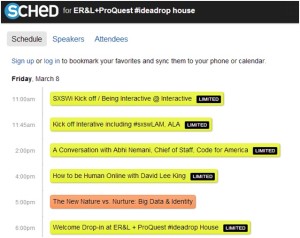Technology Learning As Process
What if we transformed the notion that technology is something to learn, and instead, cultivated an understanding of technology learning, and the support it requires, as a continuous action? This thought was fresh in my mind this week as I prepared my schedule for the South By Southwest Interactive (SXSW) conference and the Electronic Resources & Libraries (ER&L) #ideadrop house, a librarian-organized venue for all things libraries, technology, and innovation. Event organizers for both SXSW Interactive and ER&L #ideadrop use the SCHED conference scheduling tool, which was previously unfamiliar to me.
Quick learning? Necessary. Mistakes made? You know it. Two minutes into using SCHED, I had somehow created duplicate accounts. Twenty more circuitous minutes passed by before I realized that I could simply click on a star next to the session title to add it to my conference schedule. After repeatedly thinking, “There must be an easier way,” I discovered that there was, and it was there all along right in front of me. I was learning while doing, in real-time. If SCHED had real-time support available on the site, it would have saved time, frustration, and an email to the help desk (email, an asynchronous solution in synchronous times).

While we aim to learn new technologies, technology learning itself is present progressive. It’s never complete. It’s a series of ongoing teachable moments, many self-taught, across platform and purpose, and riddled with frightening stumbles of uncertainty. Whether by training or trial and error, we eventually master the necessary skills and confidence to accomplish our objectives. That is, until the next required tech tool sends us back to square one. Sometimes, that’s ok. We experiment with the latest tech thing and compare it to what we know about the one we prefer, or are most experienced using (I’m still not over Instagram’s popularity eclipsing my old friend Flickr).
At other times, we don’t have the luxury of the exploration. Technology learning is an active, integrated part of our lives. We develop operational knowledge of how to achieve a desired outcome concurrent with actually creating it. More than ever, we, along with our customers, need active, integrated solutions for obtaining synchronous support when the answers aren’t obvious. We’re all learning while doing, in real-time, every day.
Lisa Carlucci Thomas is the Director and Founder of Design Think Do, specializing in library innovation, technology, and creative services. Follow Lisa on Twitter @lisacarlucci.
—-
This article is provided by Mosio for Libraries. To receive these directly in your inbox, please register for our Patron Support Tips Newsletter.
![]()
Patron Support Simplified
www.mosio.com/libraries
–
